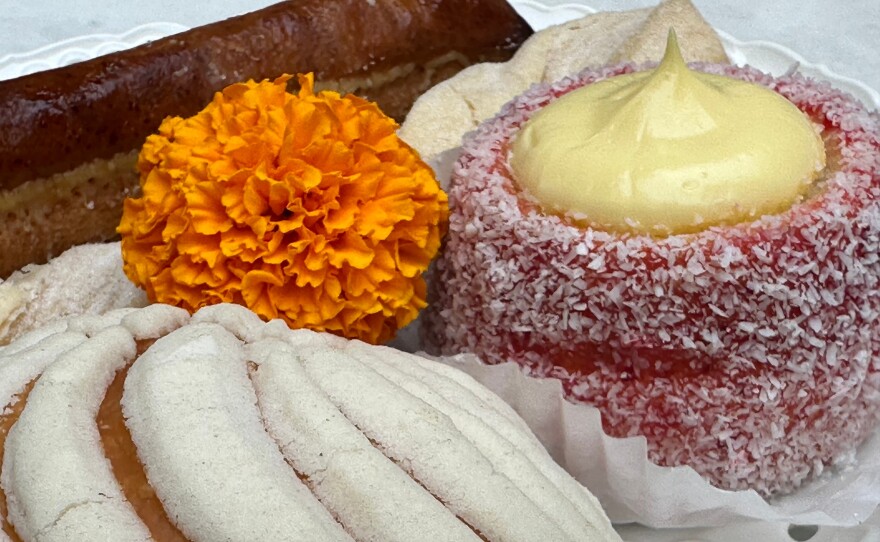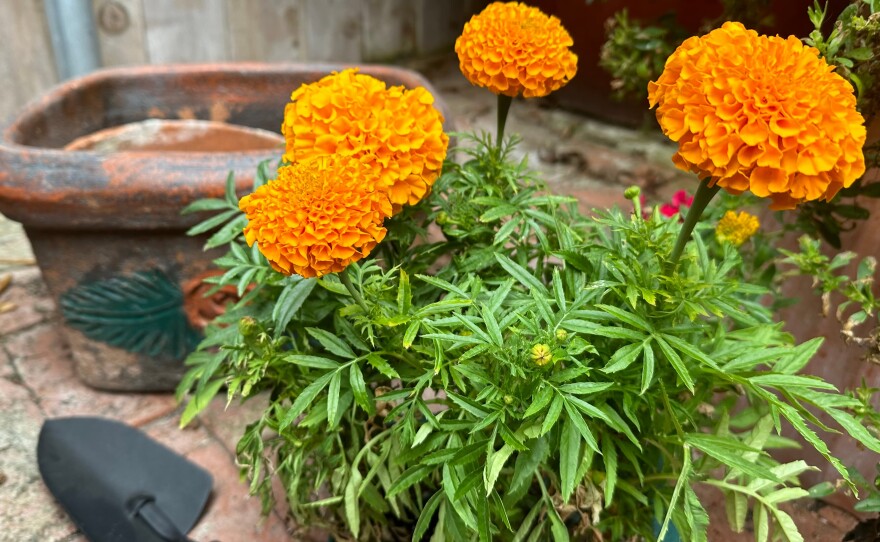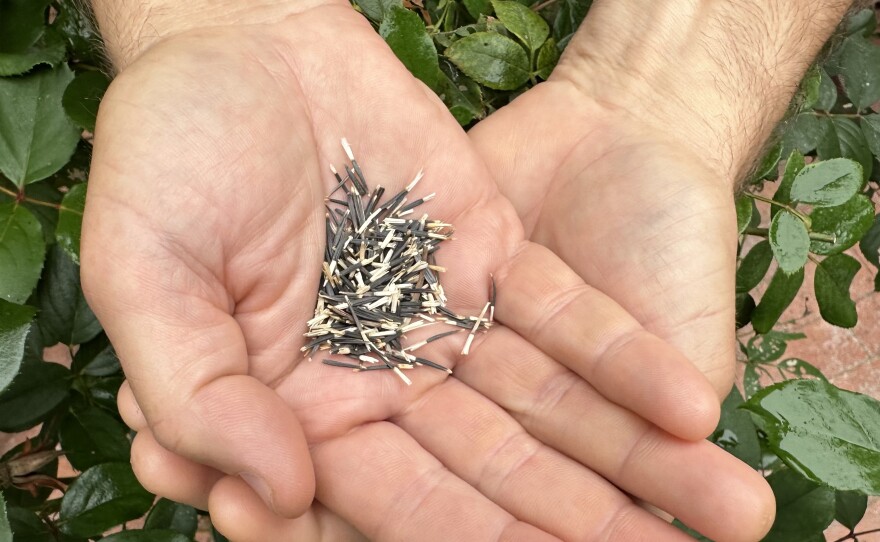Move over pumpkin spice, it’s cempasúchitl flowers (marigolds) season.
Towards the end of October, the flower of the dead will take its place on altars, in graveyards and on tombstones to honor and remember the spirits of those no longer here during Día de Muertos or Day of the Dead celebrations.
The indigenous cultures of Mexico believed its strong, bright color and scent helped guide souls to altars. Descendants of the Mayans were said to have left petals of marigolds between their homes and the graveyards.
Its connection between the world of the living and the dead is just one of many reasons it's a treasured flower in Mexico and all over the world.

Can you eat marigolds?
A cempasùchitl flower is also edible. But not every variety. It’s recommended to buy organic and to ask if it’s safe to consume.
"It goes well with pan de muerto, a traditional bread during Día de Muertos," said Rocina Lizarraga, a garden support specialist with National City's Olivewood Gardens.
According to Sophie. D Coe, author of “America's First Cuisines,” the Aztecs added Targetes lucida, a variety of marigolds, into cacao drinks. Some experts say to consume in moderation.
Marigold flowers can also go in traditional dishes from Mexico such as tamales, pulque (an ancient alcoholic beverage that is still enjoyed today) to salads, deserts, teas, and other drinks. The culinary possibilities are infinite.
Are cempasúchitl flowers good for your health?
There's research that supports that marigolds have some medicinal properties.
According to the National Center for Biotechnology Information, marigolds have antioxidants, as well as anti-inflammatory compounds and are said to help cure conditions such as indigestion or diarrhea.
How do marigold flowers do in a garden?
Some gardening experts, such as Lizarraga, claim marigolds can be protectors in the garden.
"The smell helps deter snails and aphids. We recently planted spring small marigolds at Olivewood Gardens," Lizarraga added.
The aroma is said to be armor that can keep several pests away. In the ground, they release a chemical that is toxic to nematodes, microscopic worms that hurt the roots of other plants.
"It's a super pollinator," Lizarraga said.
Pollinators like bees and butterflies are believed to benefit from marigold flowers. And they are just one of other plants that support pollinators.

Can cempasúchitl flowers be planted and grown?
Marigolds are annuals which means they bloom for one season. Ideally, the best time to plant them is in the spring or after the last frost. Some experts say marigolds can be planted late in the summer as well. They love sunlight and heat.
You can buy a starter plant and transplant it. Another option is to plant seeds indoors, wait until they germinate and then transplant them outside — this could take more than a couple of months. You can also plant seeds outside in a pot, a container, a raised bed or into the ground.
Additionally, for those new to gardening, experts say transplanting into a pot, container or a raised bed may yield better results than planting into the ground. Locally, you can find plants and seeds at nurseries.
How long it takes for marigolds to grow depends on a number of factors including what types they are, how warm the weather is and the quality of soil. Some experts estimate 70-100 days from seed to flower.
There are a lot of recommendations for growing cempasúchitl flowers, below are some tips to help plant marigold flowers.

- Find a warm location with a lot of light.
- Add a general potting mix into your starter pot.
- Slightly push in two to three seeds into the soil per pot.
- You can spray in or gently add water.
- Afterwards, you can put them over a tray and add water to keep them moist until they germinate, also known as bottom watering.
- Check in on them often and water them when the soil is dry.
- When you have seedlings, it's recommended you thin them out so you end up with one plant per pot.
- Wait until they have grown three to four inches before planting them outside.
- It can take from five to 10 days or more for the seeds to germinate.
- Experts also recommend, before you transplant, put them outside starting with short to longer increments of time, at least over a week so they can adapt to the sun and the outdoor weather.
- First, pick an area where the plants will get full sunshine.
- It’s recommended to transplant in the morning or in the evening, to avoid heat that can come from the midday sun.
- You will want to dig a hole to make room for your plant.
- If you are planting more than one, keep them at least four to six inches apart.
- If you are transplanting them into the ground consider adding compost or sand to garden soil to ensure the area has drainage abilities. Also, water the area one to a few days before.
- If you are transplanting into pots, containers or raised beds, you will want to include a potting mix.
- At planting, you will want to water the planting area and add fertilizer.
- Also before adding the plant into your pot, container, raised bed, or into the ground, if the roots are tangled, gently loosen them and then place it in the area you want it in.
- Once the water and fertilizer settle in, add the plant, and more soil to help it stay in its new location.
- Right after, add more water.
- It's recommended that after the initial planting and while its growing and establishing itself, you don't add more fertilizer, with exception of marigolds inside of containers.
- First, pick an area where the seeds will get full sunshine.
- If planting into the ground consider adding compost or sand to garden soil to ensure the area has drainage abilities.
- Also if you are planting into the ground, depending on your soil quality, you may want to add fertilizer during the initial planting.
- On the day you plant the seeds, loosen the top of the soil.
- Add water, then slightly push two to three seeds into the soil, no deeper than an inch, per section and keep them at least 10 inches apart.
- After you plant the seeds, you’ll want to add more water. Be gentle with the water to keep the seeds in place.
- Afterwards, you will want to keep the soil moist, but don't overwater.
- It’s also recommended to plant a lot of seeds because not all of them germinate.
- When they start to germinate you will want to thin the seedlings so that they don't overcrowd each other.
- If you are transplanting into pots, containers or raised beds, you will want to include a potting mix.
- It's recommended that after the initial planting and while they are growing and establishing themselves, you don't add more fertilizer, with exception of marigolds inside of containers.
When watering don’t water your plants from the top down. Add the water towards the bottom where the stem comes out of the soil.
Give your cempasúchitl flowers love by checking in on them often. Water when the soil is almost dry. Pinch off the dead flower heads, which encourages blooming. And however you experience marigolds, enjoy.






